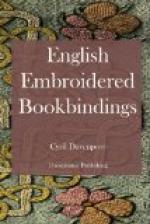The books illustrated are selected out of a large number, and I think it may fairly be considered that the most favourable typical specimens now left in England are shown. It may well be that a few finer instances than I have been able to find may still be discovered hidden away in private collections, but it is now so rarely that a really fine ancient embroidered book comes into the sale-room, that we may safely conclude the best of them are already safely housed in one or other of our great national collections. Where not otherwise stated, the specimens described are in the British Museum.
In the following detailed descriptions I have used the words ‘sides’ and ‘boards’ to mean the same thing, and the measurements refer to the size of the boards themselves, not including the back. These measurements must be taken as approximate only, as from wear and other causes the actual sizes would only be truly given by the use of small fractions of inches.
CHAPTER II
BOOKS BOUND IN CANVAS
English books bound in embroidered canvas range over a period of about two hundred and fifty years, the earliest known specimen dating from the fourteenth century, and instances of the work occurring with some frequency from this time until the middle of the seventeenth century. The majority of these bindings are worked in tapestry-stitch, or tent-stitch, in designs illustrating Scriptural subjects in differently coloured threads.
Very often the outlines of these designs are marked by gold threads and cords, of various kinds, and parts of the work are also frequently enriched with further work upon them in metal threads. Spangles are very rarely found on canvas-bound books. The backgrounds of several of the later specimens are worked in silver threads, sometimes in chain-stitch and sometimes in tapestry-stitch; others again have the groundwork of silver threads laid along the surface of the canvas and caught down at regular intervals by small stitches—this kind of work is called ‘laid’ or ‘couched’ work. Books bound with this metal ground have always strong work superimposed, usually executed in metal strips, cords, and thread. The silver is now generally oxidised and much darkened, but when new these bindings must have been very brilliant.
[Illustration: 3—The Felbrigge Psalter. 13th-century MS.]
The Felbrigge Psalter. 13th-century MS. Probably bound in the 14th century.
The earliest example of an embroidered book in existence is, I believe, the manuscript English Psalter written in the thirteenth century, which afterwards belonged to Anne, daughter of Sir Simon de Felbrigge, K. G., standard-bearer to Richard II. Anne de Felbrigge was a nun in the convent of Minoresses at Bruisyard in Suffolk, during the latter half of the fourteenth century, and it is quite likely that she herself worked the cover—such work having probably been largely done in monasteries and convents during the middle ages.




